Article Contents
Wondering what cyanuric acid for pools is and how to use it?
Cyanuric acid for pools is an essential chemical for chlorinated or salt water pools. It’s one of the key chemicals that every pool owner should know about and use.
Perhaps you’ve been wondering what exactly cyanuric acid does and how to use it? You’re in the right place if you have.
In this article we cover exactly how to use cyanuric acid (CYA), why you need to use CYA and what you should do if cyanuric acid is high in your pool or cyanuric acid is low.
Let’s get into it.
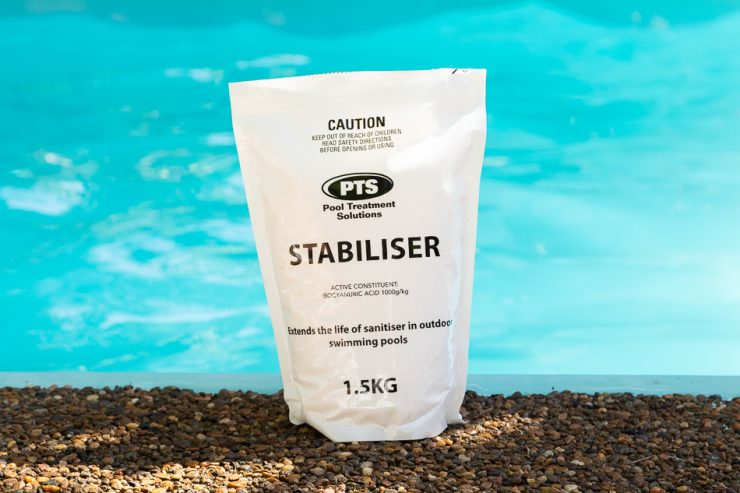
What is Cyanuric Acid for Your Pool?
Cyanuric acid in pools is a chemical added to the water to prevent the chlorine dissipating. Cyanuric acid stabilizes the chlorine so the chlorine level remains high enough to be effective in sanitizing the bad stuff, like algae and other harmful bacteria.
It is sold and marketed under several names including sunscreen for your pool, pool stabilizer, pool water conditioner, UV blockout and chlorine stabilizer as well as cyanuric acid or CYA.
If you’re looking to purchase cyanuric acid we recommend this granular cyanuric acid and this liquid cyanuric acid.
Why Do You Use Cyanuric Acid in Your Pool
Although chlorine is a very effective sanitizer for your pool, it does have a major drawback. When chlorine is exposed to ultraviolet light (UV), i.e. sunlight, a reaction takes place reducing its effectiveness as a sanitizer.
To understand this further, let’s get into some basic pool chemistry.
After adding chlorine to your pool it turns into Hypochlorous acid (HOCl) & Hypochlorite ion (OCl-). This is what’s known as Free Chlorine – it’s called Free Chlorine because it’s “free” to be used to sanitize your pool water, as opposed to Combined Chlorine, which is a measure of the chlorine that has been “used up” and is now ineffective at sanitizing the water.
Free Chlorine (FC) + Combined Chlorine (CC) = Total Chlorine (TC)
Or put another way
Total Chlorine (TC) – Combined Chlorine (CC) = Free Chlorine (FC)
When the Hypochlorous acid (Free Chlorine) is exposed to UV light, a photochemical reaction called photolysis occurs. And when this happens up to half of the free chlorine is converted to unusable chloride ion – about 35% of it will be converted within an hour’s exposure to sunlight.
So that expensive chlorine you just added, is now left ineffective, and within a few hours it cannot sanitize the water effectively.
UV light is so effective at removing chlorine that UV is used commercially for dechlorination in brewing and pharmaceutical industries.
Chlorine Degradation When Exposed to UV
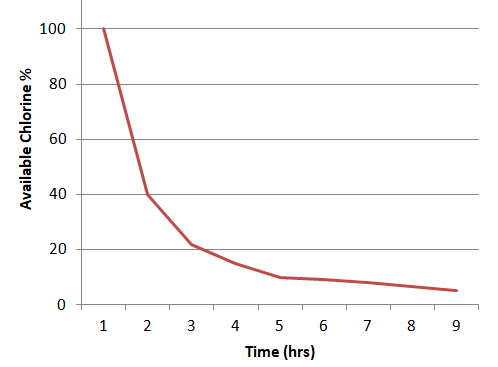
This image shows the degradation of chlorine when exposed to UV light. You can see that after only a few hours of UV exposure, there’s only a small fraction (of free chlorine) available to sanitize the water. Based on G.D. Nelson, special report No. 6862.
How Does Adding Cyanuric Acid to the Water Help?
Now you know UV light quickly renders chlorine useless as a sanitiser. And unless you have cash to burn on chlorine, you’ll want to know what to do about it.
The answer is simple. Cyanuric acid.
Adding Cyanuric Acid to your pool (AKA chlorine stabilizer or pool conditioner) will prevent the chlorine reacting to UV light thus preserving it and leaving it available to kill all those nasties in your pool water.
Chlorine Degradation When Exposed to UV with Added Cyanuric Acid
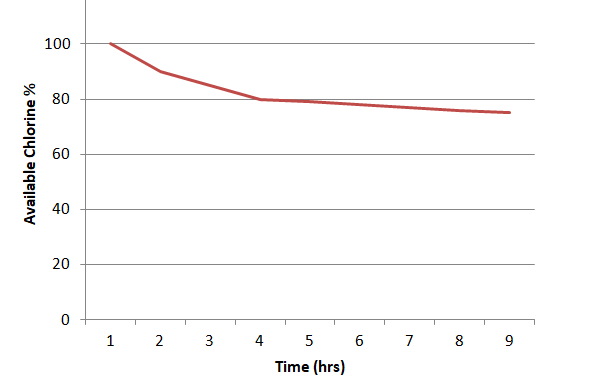
This graph shows the degradation of chlorine when exposed to UV light with Cyanuric Acid (CYA) at 50 ppm. You can see the chlorine available to sanitize remains at high levels when CYA is added to the water. Based on G.D. Nelson, special report No. 6862.
How does cyanuric acid work to stabilize and preserve chlorine levels?
In simple terms, when cyanuric acid is added, it clings onto the chlorine and forms a bond. After this bond occurs the chlorine is protected from the UV light. The bond between the chlorine and cyanuric acid (CYA) is weak and when the chlorine needs to kill off the bacteria, it is able to separate from the CYA and do its job.
Is Cyanuric Acid Bad for Pools?
In the past, before the use of cyanuric acid, chlorine needed to be added every single day because it quickly degraded. This meant that much more money needed to be spent on chlorine. And it took a lot more time to maintain a pool.
Now pool maintenance has become much cheaper and easier.
However too much cyanuric acid in your pool is definitely a bad thing.
Why?
With the addition of stabilizer or pool sunscreen, chlorine becomes less effective at sanitizing.
Required Chlorine Level Vs CYA Level
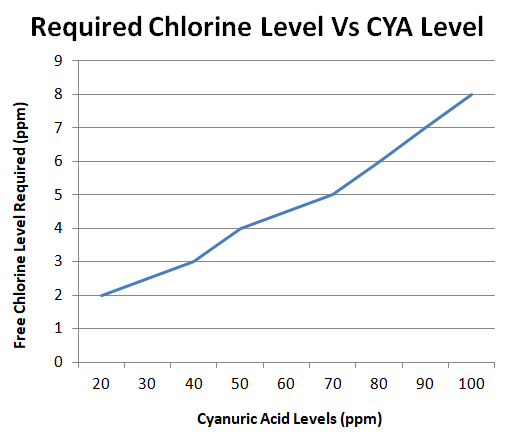
This graph shows the increasing levels of free chlorine required to sanitize the water effectively Vs the stabilizer (cyanuric acid) levels. You can see the chlorine level greatly increases when more cyanuric acid (AKA pool sunscreen) is present.
What, didn’t you just say that chlorine will degrade quickly and become ineffective if I don’t add cyanuric acid? But now you’re telling me chlorine is less effective when I add cyanuric acid too?
Yes that’s exactly right.
It’s true, if your pool has overly high levels of stabilizer (above 100 ppm) you’re going to need to add a heap more chlorine in the water to keep algae and bacteria under control.
So what’s the solution?
The good news is if you keep cyanuric acid (CYA) in the recommended range (30-60 ppm), the chlorine will still work effectively.
How Much Cyanuric Acid to Add (pool stabilizer)
The recommended range for stabilizer in pools varies depending on what sanitizing system you use.
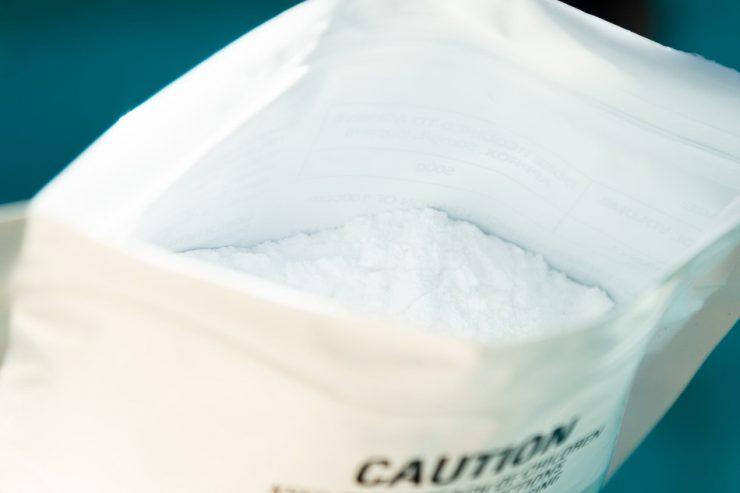
Here’s the short answer:
How much cyanuric acid is needed for chlorine pools? If you have a chlorine pool, then you’ll want to keep the levels between 30-50 ppm. The ideal level of stabilizer is 50 ppm.
How much cyanuric acid is needed for saltwater pools? About 60 ppm of cyanuric acid is ideal for salt water pool systems.
And here’s the long answer:
Since cyanuric acid reduces the ability of chlorine to clean the water, the free chlorine level you maintain in your pool will depend on the level of stabilizer in the water. You’ll want to keep free chlorine levels at about 7.5% of the CYA level.
e.g. if you have 50 ppm of CYA, then you need free chlorine (FC) to be about 3.75 ppm.
i.e. 50 ppm CYA x 7.5% = 3.75 ppm Free Chlorine (FC).
If you have 100 ppm of CYA, then you need the FC to be 7.5 ppm.
As a side note, one of the reasons to keep lower levels of CYA is that it’s not practical to maintain high levels of free chlorine capable of killing bugs such as cryptosporidium (crypto). Cryptosporidium is resistant to chlorine so it’s important that the chlorine is working well and isn’t hampered by too much CYA.
Recommended Levels Pool Cyanuric Acid Levels Vs Chlorine Levels
| CYA (Stabilizer) | Free Chlorine Required |
| 20 | 2 |
| 30 | 2.5 |
| 40 | 3 |
| 50 | 4 |
| 60 | 4.5 |
| 70 | 5 |
| 80 | 6 |
| 90 | 7 |
| 100 | 8 |
* levels are in parts per million (ppm)
The above chart shows the recommended levels of free chlorine for effective water sanitization for a given level of CYA.
Which Type of Cyanuric Acid Should I Buy?
Cyanuric acid (pool conditioner/stabilizer) is sold in different forms:
- Liquid Stabilizer
- Granular or Powder Stabilizer
- Stabilizer Tablets with chlorine (known as stabilized chlorine which is sold as Trichlor)
The question is which form of stabilizer is better? Liquid Cyanuric Acid Vs Granular Cyanuric Acid. Or stabilized chlorine?
When buying any pool chemical, not all are created equal. Some brands may have less of the active ingredient. For example, some pool conditioners/stabilizers only have 70% CYA whereas others will have 99%.
It goes without saying that you’re getting a lot less for your money if the product you purchase only has 70% CYA. Make sure you read the label carefully to check for the amount of actual cyanuric acid to see which product offers the best value.
![]() Liquid Chlorine Stabilizer/Conditioner
Liquid Chlorine Stabilizer/Conditioner
Pros: Easy to add to the pool and less messy. Doesn’t need to dissolve which has two advantages; you won’t have undissolved granules on the pool floor and the CYA level will be faster to change after adding stabilizer (within hours not days).
Cons: A lot more expensive than the granular form.
Granular Stabilizer/Conditioner
Pros: Most cost effective option – cheapest pool stabilizer.
Cons: Takes a few days to dissolve completely – can sit on the bottom of the pool before dissolving. A little more messy to add.
Stabilized Chlorine Tablets (Trichlor)
Pros: Does two things in one – stabilizes and adds chlorine. Easy to measure and add and also not messy. Some tablets are slow release and great for keeping your pool sanitized if you go on vacation.
Cons: More expensive than buying both products separately. Lack of control over chlorine levels and CYA levels. i.e. you can’t adjust each level separately.
You can buy Stabilized Chlorine Tablets here and chlorine tablet dispensers here.
How to Test Cyanuric Acid (Pool Stabilizer) Levels
How does one test for cyanuric acid?
Testing for cyanuric acid is as simple as carrying out your regular pool water testing. Most pool water test kits, such as test strips and liquid test kits, test for CYA (stabilizer) levels in addition to other essential levels such as Free Chlorine (FC), Total Chlorine (TC), Alkalinity and pH levels.
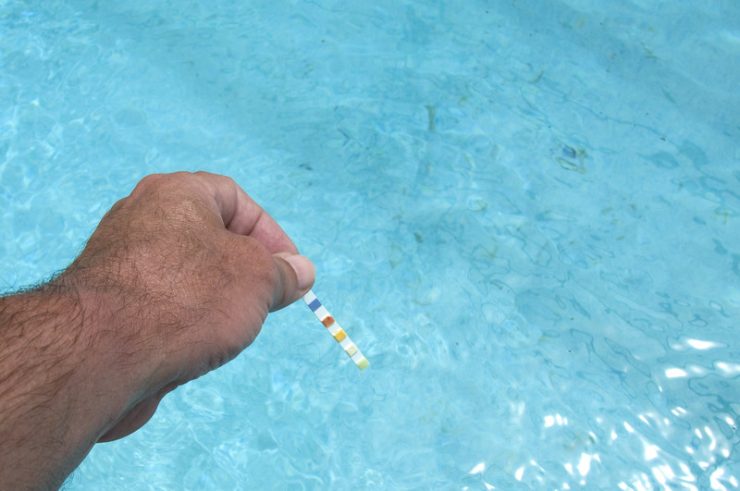
If you don’t have a pool water test kit (you most definitely should), you can also take a sample of pool water to your pool store for testing.
It’s not necessary to test CYA too regularly. But you may as well keep an eye on it when you perform your other water testing – you should be doing that at least once a week.
And if you’ve had a lot of rain, loss of water levels, topped up the pool water or recently added CYA or used a stabilised chlorine product, you’ll want to test the levels to make sure they correct.
How to Add Cyanuric Acid to Pool
1.) Check Your Pool Water Level is Correct
If not, add water and run the pump for an hour to mix in the recently added water.
2.) Test CYA/Stabilizer levels
Use a pool water test kit or take a water sample to your local pool store.
3.) Calculate the Required CYA
Read the manufacturer’s instructions then calculate how much you need to raise the pool stabilizer by.
Next work out the dose and measure it. You’ll need to know your pool water volume to do this.
e.g. let’s say you have a 24,000 gal pool. After testing your water you determine your CYA level is 40 ppm. The ideal level is 50 ppm. You need to bring up the level by 10 ppm.
After reading the instructions on your stabilizer/conditioner, you see that to raise the cyanuric acid level by 10 ppm, you need to add 1lb of CYA for every 12,000 gal of water.
So you’ll need to add 2 lbs of stabilizer/conditioner to your pool.
4.) Add the CYA to the water
Make sure you wear safety goggles and gloves – you don’t want that stuff in your eyes.
Some manufacturers instruct you to dissolve the CYA in a bucket first and pour it around the pool. This isn’t great as you’ll have undissolved CYA sitting on the bottom of your pool and this could damage your pool liner (if you have one), plus it doesn’t feel great on your feet.
You also shouldn’t put CYA directly in the skimmer box.
There are two methods to add cyanuric acid to your pool depending on if you’re using granular or chlorine stabilizer:
Method 1 – For Granular Pool Conditioner/CYA
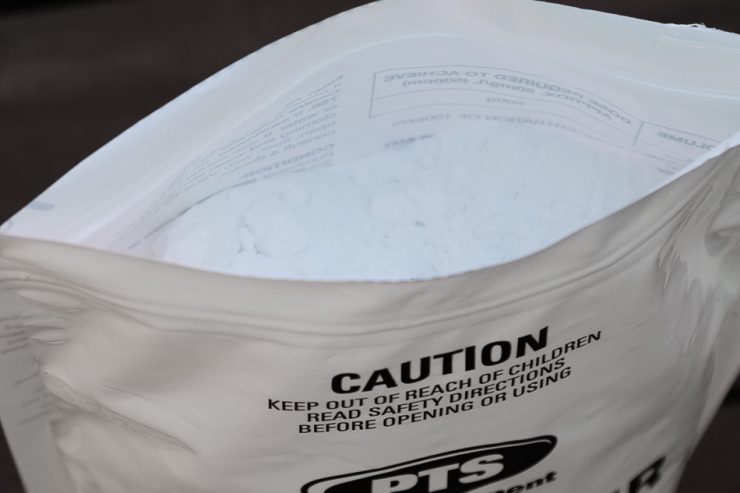
1.) Measure the cyanuric acid
2.) Put the CYA in a pool skimmer sock and then hang the skimmer sock to one side of the skimmer or in front of the return flow jet.
Alternatively, you could fill a large bucket 2/3 full with warm water, add the powder CYA to the bucket and stir. Then add it to the skimmer box.
The disadvantage of this method is you may get undissolved granules on the pool floor for a few days.
3.) Turn the pump on for the first 24 hours and then run regularly for the next week. The CYA will slowly dissolve. It may take several days.
Avoid backwashing for about one week or you risk discarding some of the cyanuric acid if it hasn’t dissolved fully.
Method 2 – Liquid Stabilizer/Water Conditioner
1.) Measure the liquid cyanuric acid into a bucket.
2.) Tip it directly into the skimmer box or alternatively, you can walk around the pool and tip it in slowly.
3.) Turn the pump on for 3-6 hours.
5.) Retest the water
Wait for 4-5 days when using granular CYA to ensure it is dissolved then retest the CYA levels.
For liquid stabilizer, you can retest after 3-5 hours – just leave enough time for the pool water to be fully circulated and for the stabilizer to be mixed in thoroughly.
Since the CYA level will have increased, this means you may also need to increase your free chlorine levels. See the above table for recommended free chlorine levels Vs CYA level.
Cyanuric Acid (Pool Stabilizer) FAQs
Cyanuric Acid Low In Pool
If your cyanuric acid is low, this is something you should rectify quickly. As mentioned earlier, without adding CYA, chlorine will degrade in a matter of hours when exposed to the sun.
To bring up the CYA levels quickly, you can add a liquid or granular CYA. Liquid stabilizer will take a few hours to raise the levels. Granular or powdered stabilizer can take several days as it takes time to dissolve properly. Test the levels again after adding.
For a slower release CYA product, you can use stabilized chlorine tablets (trichlor or dichlor).
For a detailed guide on low cyanuric acid, check out our article:
How to Raise Cyanuric Acid Level in Pool
Is It Safe To Swim In A Pool With High Cyanuric Acid?
Whilst swimming with high cyanuric acid levels doesn’t pose any risk from the CYA itself, the sanitizer in your pool will be less effective and could put you at risk of picking up a bug due to unsanitary water.
If your cyanuric acid levels are high, you’ll need much higher levels of chlorine for it to be effective. See the chart above for the CYA and corresponding chlorine levels.
Cyanuric Acid High In Pool
High cyanuric acid levels should be solved fairly quickly. When you have high cyanuric acid levels in your pool you’ll need to add more chlorine than normal or you risk algae and other bacteria.
The easiest method is to partially drain your pool water and then top the pool water back up. This has the effect of watering down the concentration of cyanuric acid and lowering the levels.
For a detailed guide on high cyanuric acid, check out our article:
How to Lower High Cyanuric Acid
When Is It Safe To Swim After Adding Cyanuric Acid?
As a general rule though, you can swim in your pool within 20 minutes of adding cyanuric acid. Make sure you have the pump on when you add it so that it mixes in the water.
It’s always best to check the manufacturer’s instructions though.
Do Hot Tubs or Spas Need Cyanuric Acid (Stabilizer)?
It’s best not to use CYA in hot tubs or spas. As already mentioned, CYA decreases the ability of chlorine to sanitize the water. The warm water temperatures in hot tubs and spas are a potential breeding ground for bacteria and other nasties. Therefore, it’s best not to add any CYA to ensure you avoid this risk.
Plus spas and hot tubs are generally not exposed to UV light as much as a swimming pool is – unless of course you have an outdoor hot tub which you like to soak in all day.
The best practice for hot tubs and spas is to test the water often and add sanitizer regularly or as required.
Should You Use Cyanuric Acid in Indoor Pools?
Cyanuric acid is not needed for indoor pools as they are not directly exposed to UV light (sunlight). Cyanuric acid is only to protect free chlorine loss from sun exposure. Some councils prohibit the use of cyanuric acid in indoor pools. Check with your local authority for recommendations.
Cyanuric Acid (CYA) Not Dissolving
Some people have reported that cyanuric acid is not dissolving in their swimming pool.
When CYA won’t dissolve, this usually occurs when not enough time has been allowed. It can actually take 4-7 days for the CYA to dissolve so it’s just a matter of being a little patient.
If you’re having this issue, check out our article:
How to Dissolve Pool Stabilizer
Can I Put Cyanuric Acid in the Skimmer Box?
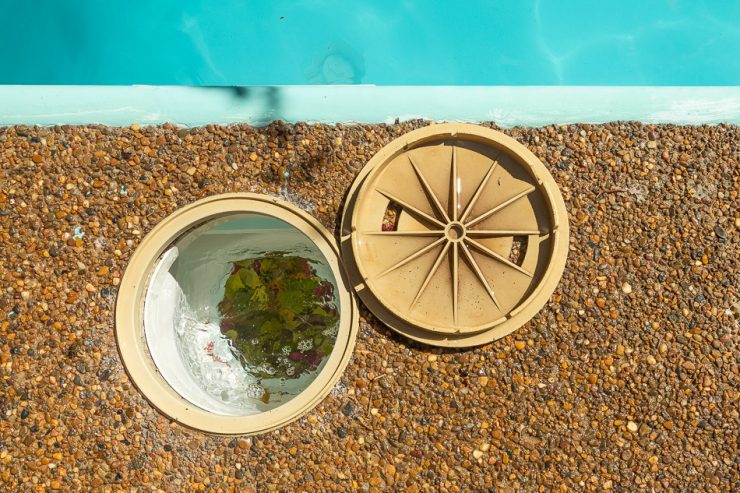
It’s normally OK to add cyanuric acid to the skimmer box but it’s better to add it in a skimmer sock though so it doesn’t get stuck in the filter. Having CYA in the filter isn’t so much of an issue though because it will eventually dissolve.
But it will mean you won’t be able to backwash until the cyanuric acid is fully dissolved or you run the risk of washing away your expensive chemical.
Summary
If you’ve read this far, congratulations is in order! You should now know more than most people when it comes to cyanuric acid in pools.
The key points are:
- Cyanuric Acid is necessary to preserve chlorine in pools that are exposed to sunlight.
- Keep the CYA levels between 30 and 60 ppm – any higher and chlorine quickly loses its effectiveness as a sanitiser.
- And finally, be careful when you’re using stabilized chlorine products. Since stabilizer stays in the water, CYA levels will slowly creep up.
I would love to hear about your experiences with your pool when it comes to cyanuric acid.
Happy Swimming!
Recommended Products
Cyanuric Acid – granular form
Cyanuric Acid – liquid form
Related Reading:
Cyanuric Acid Low in Pool | How To Raise Cyanuric Acid

